Portugal is famed for its golden sandy beaches, hidden coves and monumental castles. From its sloped cities to dense forest, here are 20 famous landmarks in Portugal to see. So, grab a pastéis de nata (Portuguese custard tart) and plan your next getaway.
Contents
20 Incredible Landmarks in Portugal
Landmarks in Lisbon
1- Torre de Belem
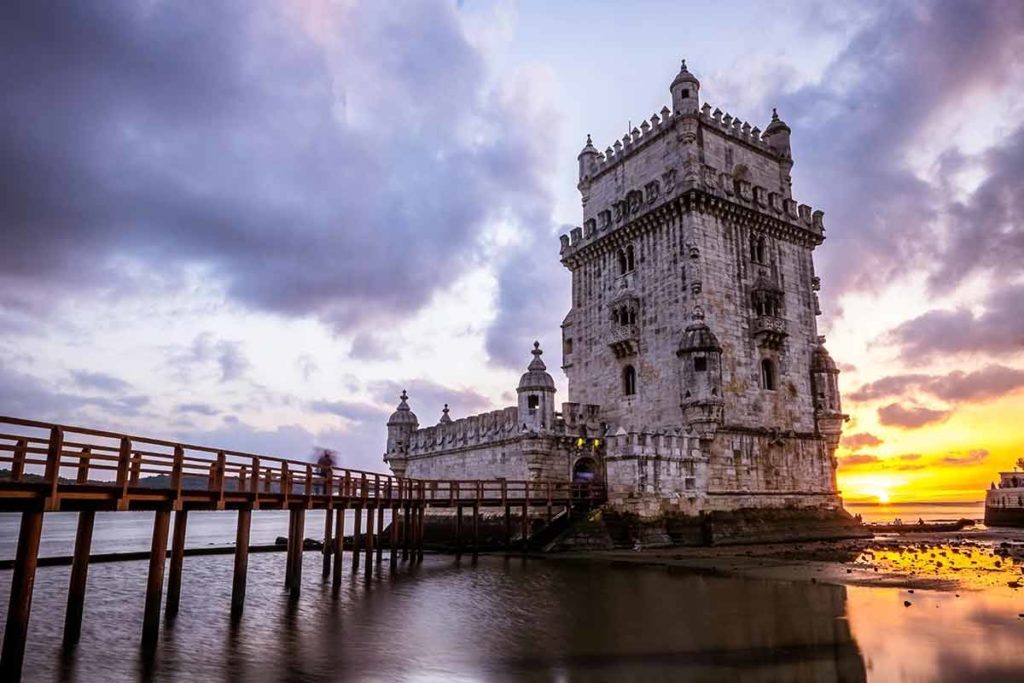
The Torre de Belem, or Belem Tower, was built in the early 1500s and became a world heritage site in 1983.
Photographing this Lisbon landmarks is one of the top things to do in Lisbon.
The tower itself is on the northern banks of the Tagus River in Lisbon and was designed to defend Lisbon from attack.
In later years, the tower would become a lighthouse and a customs building.
The tower has five floors, with spiral staircases connecting them, leading visitors to the roof terrace.
Visitors should look out for a rather unusual gargoyle on the western facade.
Carved to reflect the shape of a rhino, the gargoyle was designed after the first rhino arrived in Portugal from India in 1513.
2- Troia
The Troia Peninsula is a beautiful resort town south of Lisbon.
The resort itself has many impressive hotels and casinos, but the true landmark of this area is its location.
Troia is at the end of a narrow spit of land, the majority of which is white sand beaches edging away from thick forests to the ocean beyond.
The land split was first settled by the Phoenicians and later became a Roman fishing town.
Fishing and fish salting was an important part of life in this area, and in the fishing community of Carrasqueira, you can see the traditional reed houses and narrow fishing boats moored on mudflats.
The area lies within the Reserva Natural do Estuario do Sado, a protected wildlife area famous for its birdwatching.
Landmarks in Europe:
For more amazing European Landmarks, read:
- 30 Spain Landmarks
- 20 Switzerland Landmarks
- 22 Germany Landmarks
- 35 London Landmarks
- 30 France Landmarks
- 20 Italy Landmarks
- 20 Greece Landmarks
- 20 Russia Landmarks
- 20 Scotland Landmarks
- 20 Ireland Landmarks
- 21 Wales Landmarks
- 20 Turkey Landmarks
- 20 England Landmarks
- 20 Hungary Landmarks
- 21 Romania Landmarks
- 20 Ukraine Landmarks
- 20 Athens Landmarks
- 20 Rome Landmarks
- 20 England Landmarks
- 20 Portugal Landmarks
- 20 Poland Landmarks
- 20 Iceland Landmarks
- 20 Bulgaria Landmarks
- 21 Croatia Landmarks
- 20 Bulgaria Landmarks
- 20 Austria Landmarks
- 21 Finland Landmarks
- 20 Sweden Landmarks
- 20 Denmark Landmarks
- 20 Belgium Landmarks
- 20 Netherlands Landmarks
- 20 Barcelona Landmarks
- 21 Czech Republic Landmarks
- 20 Landmarks in Paris
- 20 Landmarks in Liverpool
- 10 Istanbul Landmarks
Natural Landmarks in Portugal
3- Peneda-Gerês National Park
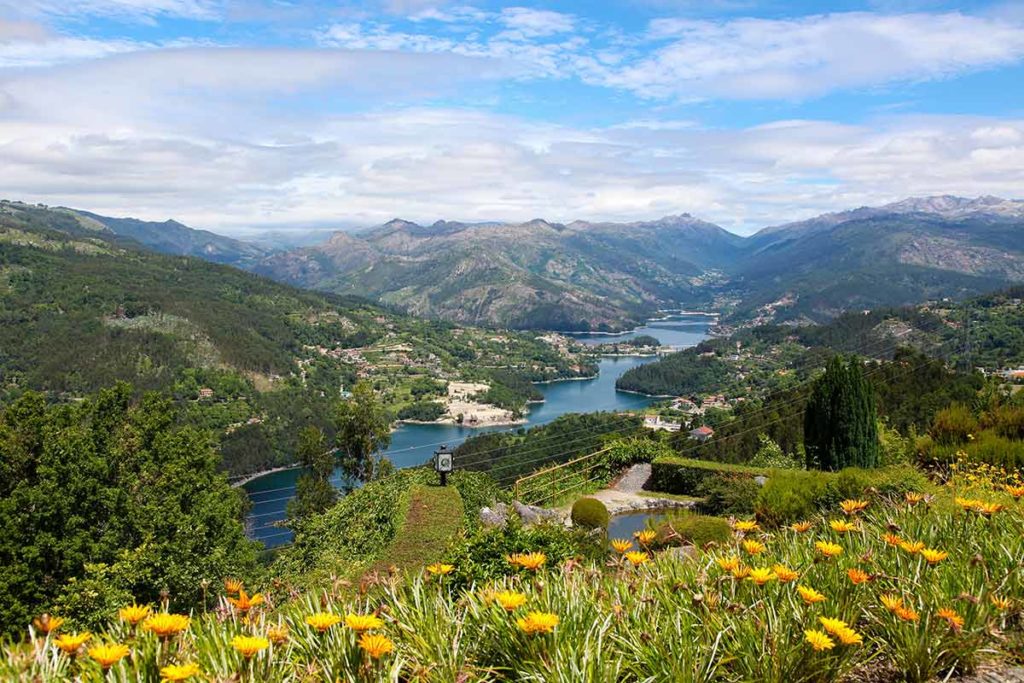
Peneda-Gerês National Park was created in 1971 in northern Portugal.
The main draw of the park is the dozens of granite villages that have stood there since the 12th century.
The villages here are not preserved as monuments and are still lived in by locals who follow the old ways.
One such village is Castro Laboreiro, located at 1000 meters above sea level.
This village offers spectacular views over the national park from the ruins of its castle. Wander closer to the Spanish border to find Portela do Homem waterfall, the most famous waterfall in the park.
The waterfall is in the Mata da Albergaria forest, a protected area of the park.
4- Berlengas Grande
Berlengas Grande is a tiny island within the Berlengas Nature Reserve.
The island is famous for its caverns, twisting rocky crags, 17th-century fort and the wildlife that calls it home.
The fort of St John the Baptist was constructed on the island from the ruins of an old monastery.
The fortress itself is connected to the island by a snaking walkway over the ocean.
Brave tourists can spend the night camping within its walls.
The best way to see all the islands have to offer is through a boat tour, which allows visitors to see the incredibly rich marine life, step foot on the islands, and hear many tales about pirates and smugglers.
5- Benagil Cave
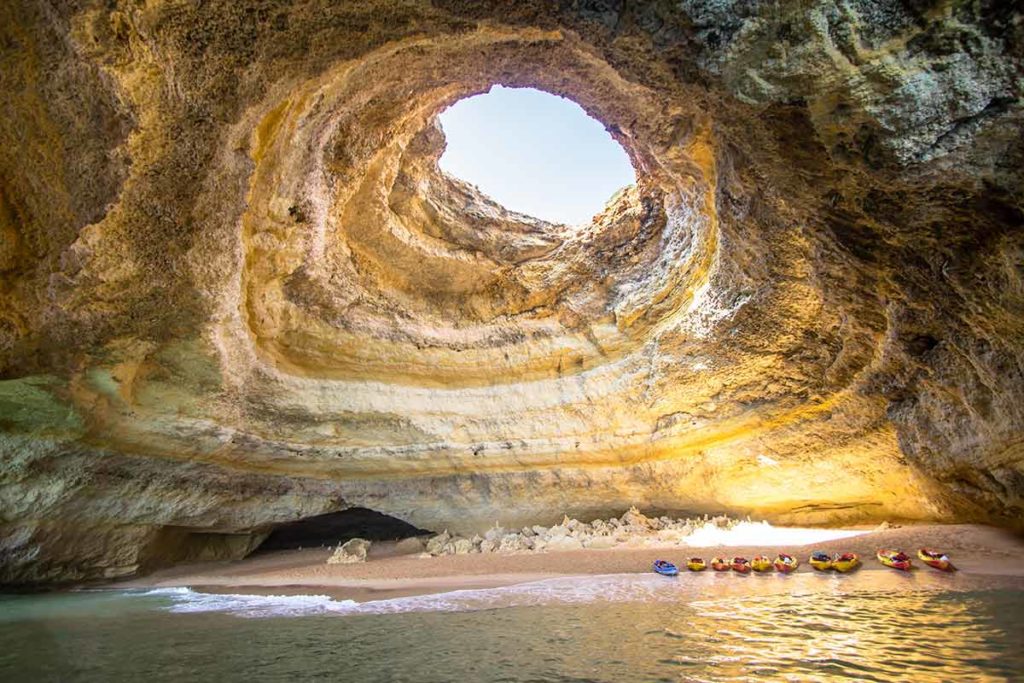
At first sight, the small fishing village of Benagil is simply another stunning place to wander for an hour or so or to grab some lunch at one of its beachfront restaurants.
Benagil, however, is more than a golden sandy beach with intriguing rock formations.
Benagil Cave, located around the corner from the beach, is an incredible natural landmark.
Accessible only by water, and it is recommended to use a paddleboard or kayak to reach it due to changing tides and strong currents, the cave is a secluded piece of paradise.
The cave itself features a small sandy floor beneath a natural sky-light opening in the cave ceiling.
Boat tours also often frequent the cave as part of their sightseeing tours of the Algarve region.
The cave is extremely busy during the summer months, so head here in late autumn or early spring to avoid the crowds.
After exploring the cave, head east to the smuggler’s cove of Carvalho, accessible only by climbing down a hidden staircase.
6- Ria Formosa Natural Park
Set in the Algarve region of Portugal, Ria Formosa Natural Park is a coastal lagoon which constantly changes due to the tides and winds.
The park itself is home to many aquatic species of birds and is an important stopping point for birds during migration season. It is also home to the Portuguese Water Dog which is native to the region and was almost threatened with extinction in recent decades.
Stop by Forte do Rato, or The Fortress of the Mouse, to the east of Quatro Aguas to see the ruins of the 16th-century fort.
7- The Azores
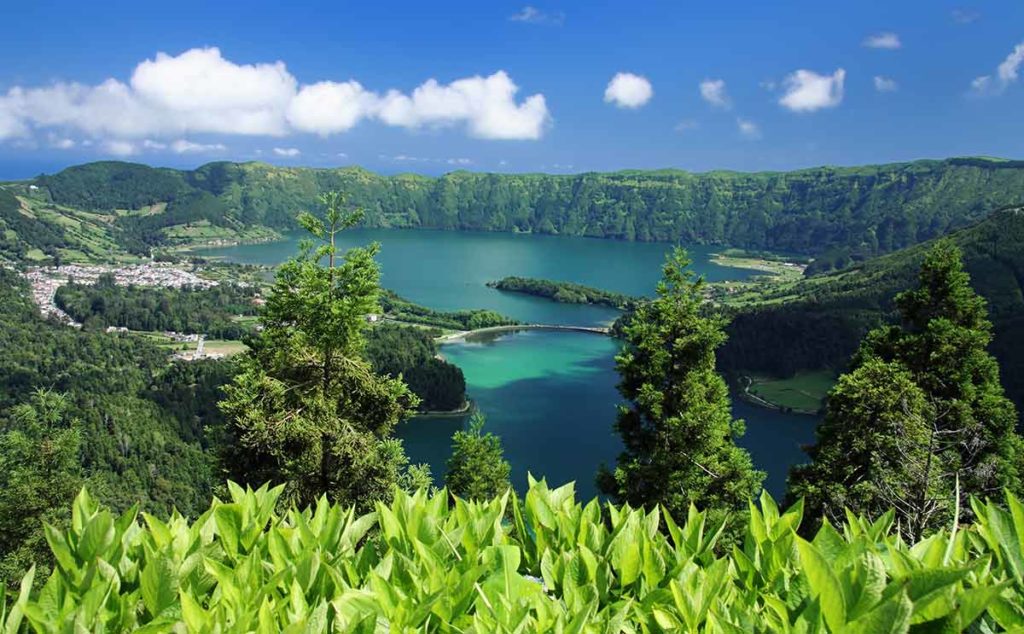
For those wanting to escape the bustle of Portugal’s cities or who fancy a change of scenery from the breathtaking natural parks, a short flight to an archipelago in the middle of the Atlantic will land you on The Azores.
Referred to by some as the Other Eden, the Azores are a collection of Portuguese islands comprised of the tips of underwater mountains.
The landscapes here are truly a wonder of nature and a must-see landmark for keen travellers.
The islands offer visitors hidden caverns, grottoes made from molten rocks, crfystal clear blue lakes surrounded by lush forest and with a coastline that boasts the most incredible whale watching opportunities.
The islands themselves are primarily natural, with just 5% of the land developed for housing and infrastructure.
This allows the islands to be a paradise for protected areas and marine reserves, and be named the worlds top destination for sustainable tourism.
A day is not enough here.
Historic Landmarks in Portugal
8- Bom Jesus do Monte in Braga
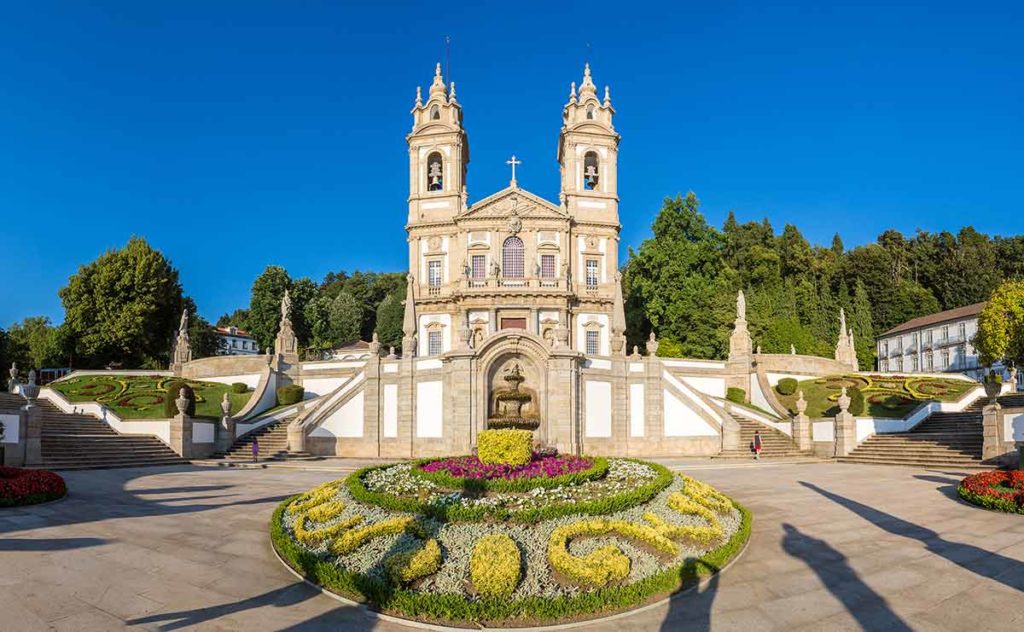
On the slopes of Mount Espinho lies UNESCO World Heritage Site Bom Jesus do Monte in Braga.
The sanctuary and the sacred mountains in which it is located has celebrated the Catholic faith here for over 600 years.
The Baroque style sanctuary consists of several chapels housing famous statues, fountains, sculptures and formal gardens.
The buildings themselves though are worth the visit alone; granite with whitewashed plaster facades, exposed stonework edgings, and stunning sculptures against an azure backdrop add to the tranquillity of this sanctuary.
A highlight of visiting the refuge is the Stairway of the Five Senses, a stairway leading to a chapel featuring more statues, fountains encapsulated in the Baroque style, and surrounded by lush woodland.
9- Guimarães
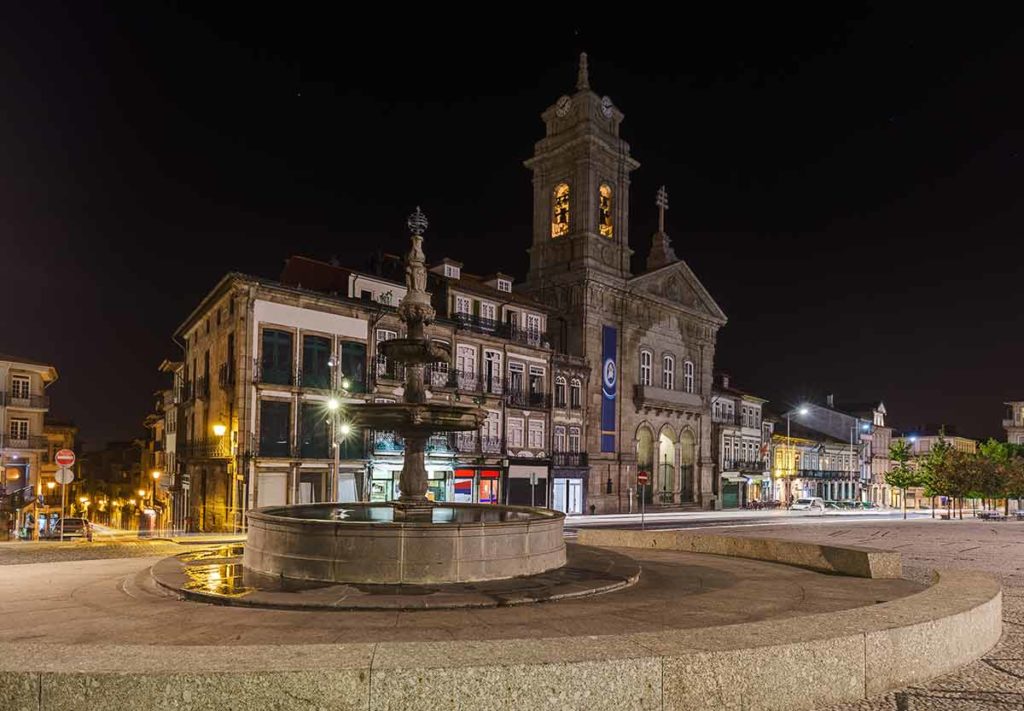
The city of Guimarães is in the north of Portugal, and like many areas of incredible beauty, architectural prowess and historical importance in Portugal was declared a world heritage site by UNESCO in 2001.
An ancient city, Guimarães is often linked with the birth of Portugal.
The city itself has beautiful Gothic buildings and plazas where you will find locals pausing for lunch or coffee. However, its ancient castle has long been considered a landmark of incredible importance.
The castle, small in size, is partially a ruin and had acted as a defence for the city from both Moorish and Norman attacks.
The palace was inspired by 14th-century northern European architecture.
Today, the castle opens its doors to visitors and has been restored to its former 17th-century glory.
10- Pena Palace
An incredible feat of architectural design, Pena Palace is one of the most famous landmarks in Portugal.
Designed in a Romantic style in the 19th century, the palace features bold yellow walls, decorative battlements and statues featuring a range of mythological beasts and heroes. The interior has recently been renovated in a 1910 style.
The palace is surrounded with lush forests, where yet more mythological statues can be found in its hidden walkways.
The palace offers incredible views over the surrounding areas from a large number of terraces, the most popular being the Relogio de Sol, or Queen’s Terrace, which offers views from bold yellow plasterwork over the region of Sintra.
11- Quinta da Regaleira
In the heart of the Sintra region lies Quinta da Regaleira, a castle of spectacular design and curious history.
The castle itself sits on land that has had historical impacts on the region since the early Neolithic period.
The castle combines a unique range of architecture, ranging from Moorish features to Egyptian design.
The castle, however, is only a small part of why Quinta da Regaleira is a must-see landmark of Portugal.
Within the grounds are two spiralling wells that go deep underground.
Unlike many wells on properties such as this, these wells were never designed for water collection.
The wells are known as initiation wells and feature a spiral staircase running down the walls, which for many historians reflects death and rebirth.
Many believe that the wells and the unusual way in which they were constructed has links to Masonic rituals and the Knights Templar.
This is a lovely spot for those interested in photography, history, and those interested in intriguing stories shrouded in legend to spend an afternoon exploring.
12- Obidos
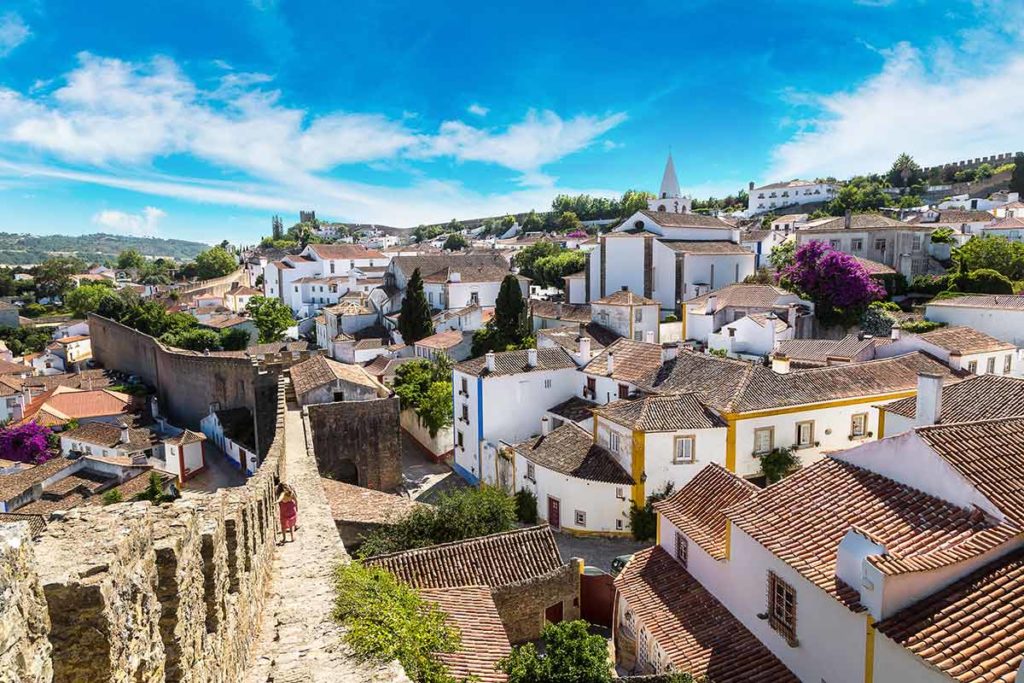
A walled town filled with bright white houses with terracotta roofs and splashes of flower-filled window boxes, Obidos is a delightful place to explore.
The houses here have their corners painted bright yellow or blue, and combined with Gothic doorways and beautiful tile work, a camera is a must to capture the charming beauty this small town offers.
The town itself was given to Queen Isabel by her husband King Dinis on their wedding day in 1282, lending the name of ‘Wedding Present Town to Obidos’.
It’s easy to be swept away by the romanticism of the town with its 12th-century castle and walls that encircle the town, to the beautiful fountains.
A visit to the town in July will allow you to step back in time to the towns medieval past as the streets are filled with music, food, and theatrical performances reminiscent of the time when the town was founded.
13- Alcobaca Monastery
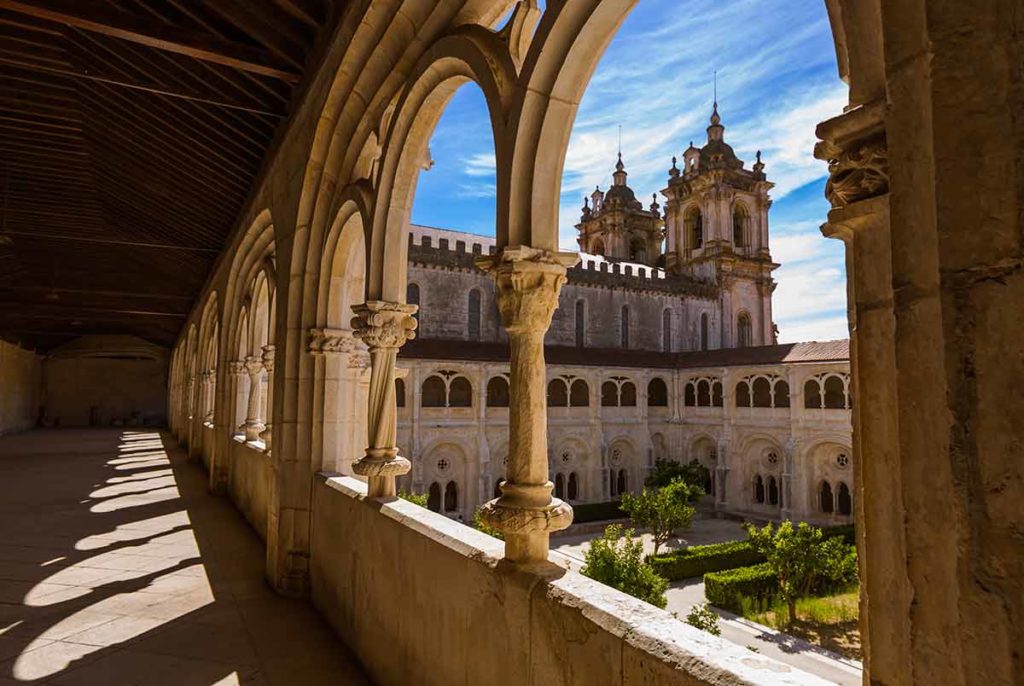
Like so many buildings of significance in Portugal, Alcobaca Monastery is a prime example of Gothic architecture.
The church itself was built in 1153 on the orders of King Alfonso Henriques to celebrate his ruling dynasty after the Moors fled central Portugal during the Crusades.
A stroll through the quadrangle will lead you to the Cloister of Silence, a dual-layered corridor with delicately arched windows overlooking the greenery beyond the high walls.
The monastery is not without a rich and colourful history beyond the religious men who worshipped here.
The tomb of Ines de Castro, the murdered wife of King Pedro, is guarded by four gremlins representing her assassins.
The distraught king had his wife’s body exhumed and placed in her throne within the monastery and demanded courtiers kiss her hand.
The tombs of King Pedro and Ines were severely damaged in 1810 following an attack from French soldiers who believed the tomb housed exquisite treasures.
14- Monsanto Village
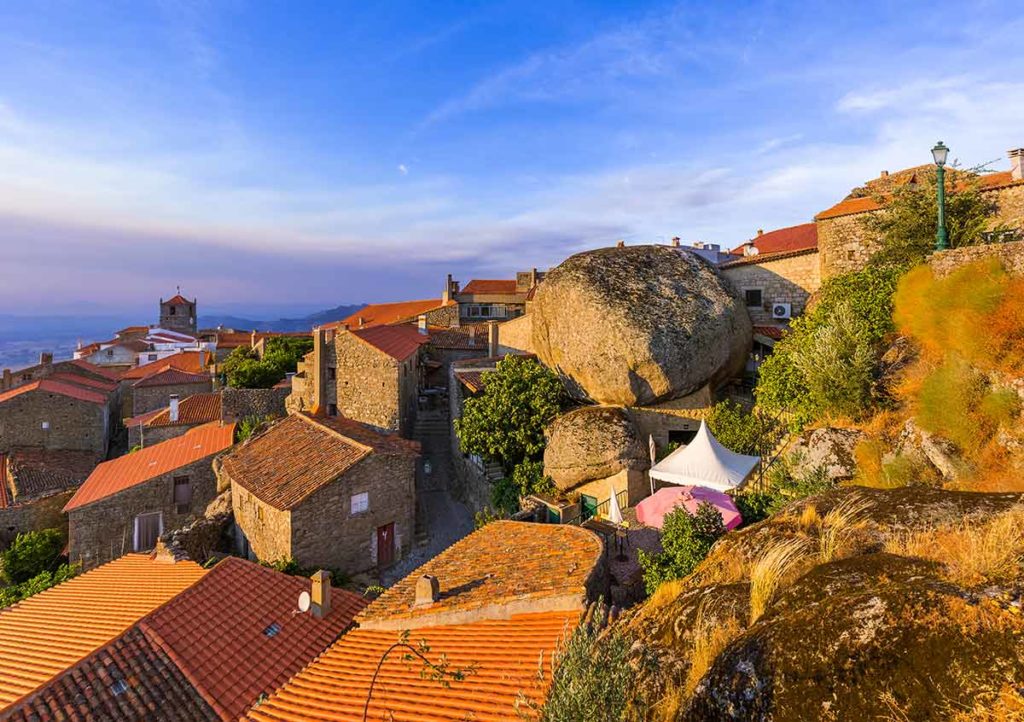
Monsanto Village was named the most’ Portuguese town in Portugal’ in 1938.
However, the town’s unique geography seems to defy this, for the houses here are sandwiched between and build into giant boulders.
Perched on a mountain with stunning views of the Portuguese countryside, Monsanto has its roots in strategic military history.
This Templar castle was partially destroyed in the 19th century by an explosion, looks over the town.
The town is a living museum, as due to its unusual location no changes can be made due to the boulders.
The streets wind upwards at a steep incline, and the houses all feature similar red roofs. Some boulders even have doors or windows cut into them, leading to more unusual structures.
Monsanto truly is a unique and magical town, and well worth its landmark status.
Discover more Famous World Landmarks:
- 25 Australian Landmarks
- 20 New Zealand Landmarks
- 20 African Landmarks
- 21 Egyptian Landmarks
- 20 Jordan Landmarks
- 10 Tasmanian Landmarks
- 20 Antarctica Landmarks
15- Casa de Mateus
Considered one of the most fantastic examples of Baroque architecture in Portugal, Casa de Mateus was built during the early 18th century within the grounds of a large farm.
The palace is home to the Mateus Foundation, which sponsors several local and national activities encouraging creative outlets from music, literature and ceramics.
The palace is fronted with a large pond, giving reflections of its magnificent carvings and decorative facade across the water.
Mateus is famous for its wine, and within the grounds of the palace wine tasting is offered, and visitors can take a tour of the wine production areas to learn more about this famous winery and its history.
16- Castelo dos Mouros
The Castelo dos Mouros, or Castle of the Moors, is nestled inside the Serra De Sintra forests.
Built in the 9th century by the Moors, the castle was designed to guard the town of Sintra and only fell during the Christian conquest.
During the 19th century, the castle was restored by King Ferdinand the Second, who wanted to keep some of its romantic ruin features.
Like many castles in the Sintra region, the views from the top of the crumbling battlements are spectacular.
The castle entrance is only 200m away from the entrance to the Pena Palace.
17- Livraria Lello
A bookshop since 1906, Livraria Lello in Porto has been delighting patrons with its spectacular collection of books, and its show-stopping crimson forked spiral staircase.
Founded by the Lello Brothers, the bookshop’s aim is to entice literary enthusiasts and encourage literary creativity.
The bookshop was renovated in 2017 to restore much of the original design including the incredible stained glass ceiling.
The bookshop is said to be the inspiration of JK Rowling’s fictional bookshop Flourish and Blotts in the Harry Potter series, and to pay homage to this, Livraria Lello has an area dedicated to the books and films.
The bookshop is architecturally a sight to behold in the Gothic style, with ornate carvings inside and intricate paintings adorning the facade.
Livraria Lello also has a special room where the shops oldest and rarest books are housed to protect them from damage.
Visit in the winter months when the crowds of tourists have subsided to enjoy the wonder of this spectacular building truly.
18- Mosteiro Palacio Nacional de Mafra
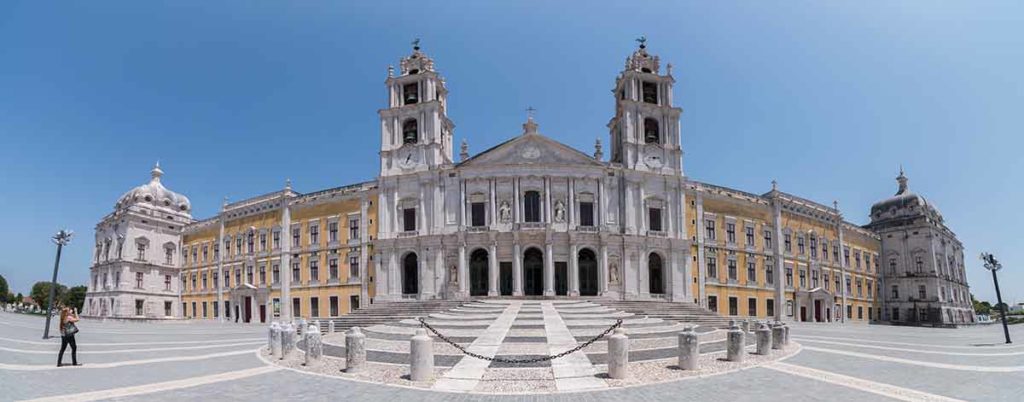
In the town of Mafra lies Mosteiro Palacio Nacional de Mafra, a palace constructed in 1717 by King Joao the Fifth.
The building was intended to be a monastery, but the design soon became grander, with gold from Brazil being ordered to complete the design.
The palace has 1200 rooms and was designed in a Baroque style.
One of its grandest features is the library.
Built in the shape of a cross, the library has an intricate marble floor, and Rococo styled wooden bookcases.
The books themselves consist of more than 40,000 books all with gold-lettered spines.
The library’s prized possessions include Theatrum Orbis Terrarum by Abraham Ortelius from 1595 which is considered to be the first modern atlas, and a trilingual bible dating from 1514.
19- Convento de Cristo
Overlooking the river Nabao is Convento de Cristo. Despite being known as a convent, Convento de Cristo was built in 1160 a the headquarters for the Knights Templar.
With many members of the Knights Templar being burnt at the stake all over Europe due to fears the Pope was growing too powerful, King Denis the First took pity on the Knights, and renamed them the Order of Christ to protect them.
Over time, the Order became demilitarised into a purely religious order.
The convent expanded over the years to include a castle and an aqueduct.
The buildings themselves reflect the styles of when they were built, giving the convent an unusual architectural feel with buildings from Romanesque to Renaissance styles.
Today the convent is preserved as a museum and was granted world heritage status in 1983.
Take a stroll through the pristinely manicured gardens and climb to the top of the hilltop castle for views over the surrounding areas.
20- Portugal’s Chapel of Bones
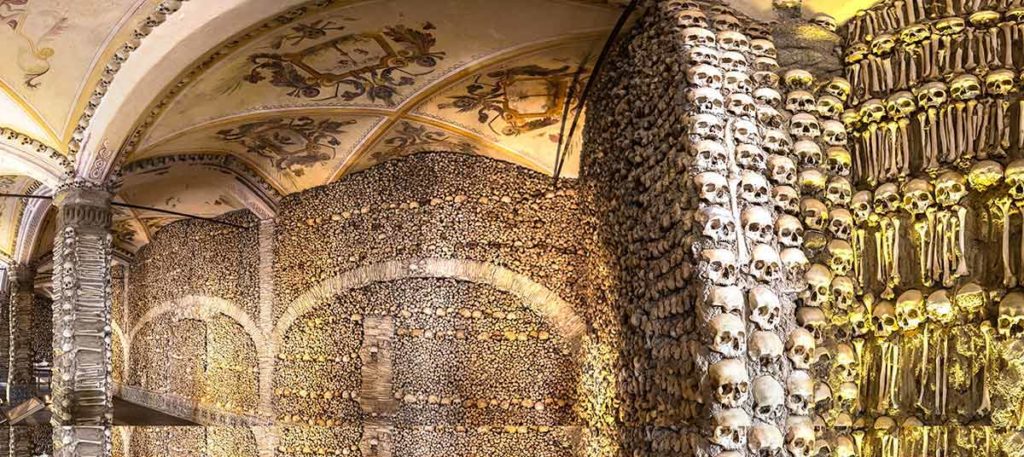
Hidden inside the Royal Church of St. Francis in Evora is the Chapel of Bones.
In the 16th century, the area in and around Evora housed 43 cemeteries, taking up valuable land that needed to be built upon.
To allow the souls of the people buried in these graves to be protected from being condemned to hell, the monks built the chapel to relocate the bones.
The bones were put on display in the style of San Bernadino alla Ossa in Milan, where the bones fill the walls.
Within the chapel are the bones of approximately 5000 corpses, including a white coffin by the altar which holds the bones of the monks who founded the chapel.
Above the chapel door is a simple message to those who enter “Nós ossos que aqui estamos, pelos vossos esperamos,” or: “We bones, are here, waiting for yours.”
This message was written with the intent to remind the townsfolk of the undeniable presence and reality of death and to help them detract from their desires for materialistic things.
Also read:
- 20 Landmarks In Portugal
- Best Time To Visit Portugal
- 20 Portugal Beaches
- 16 Things To Do In Lisbon
- 20 Things To Do At Night In Lisbon
- 20 Things To Do In Porto
- 20 Day Trips From Porto
- 20 Things To Do In Portugal
- Christmas in Portugal
- 20 Best Cities in Portugal
- 20 Things To Do In Albufeira
- 20 Things To Do In Faro
- 20 Things To Do In Lagos
- 20 Things To Do In Sintra
- 20 Best Tours In Portugal
- 20 Things To Do In Braga
- Where To Stay in The Algarve
- 20 Things To Do In Aveiro
- 20 Things To Do In Coimbra
- Where To Stay In Lisbon
- 20 Things To Do In Portimao
- Where To Stay In Porto
- 20 Best Restaurants In Porto
- 20 Portuguese Food Dishes To Taste
- 15 Things Portugal Is Famous For
- 10-day Portugal Itinerary
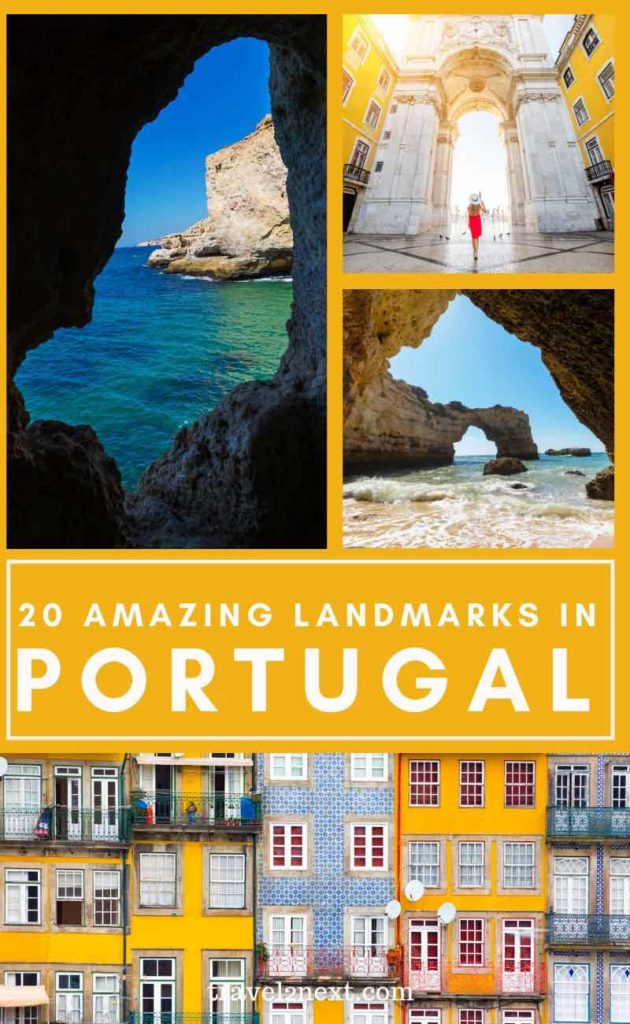
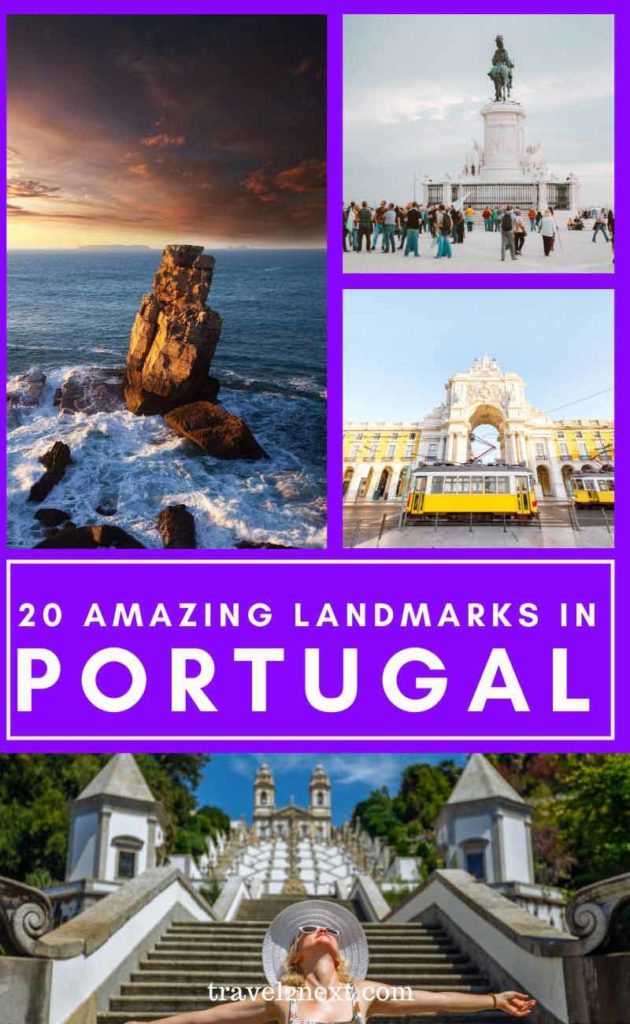
Plan Your Trip

Rent A Car – Find the best car rental rates at Discover Cars. They compare car hire companies to provide you with the best deal right now.

Find A Hotel – If you’re curious about this article and are looking for somewhere to stay, take a look at these amazing hotels.

